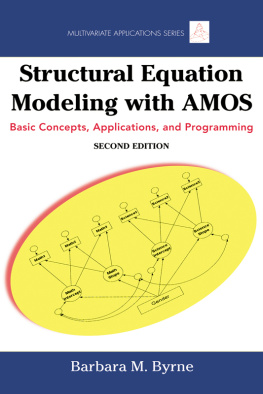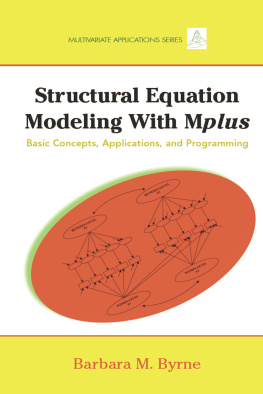Byrne - Structural Equation Modeling With AMOS
Here you can read online Byrne - Structural Equation Modeling With AMOS full text of the book (entire story) in english for free. Download pdf and epub, get meaning, cover and reviews about this ebook. publisher: Taylor and Francis, genre: Home and family. Description of the work, (preface) as well as reviews are available. Best literature library LitArk.com created for fans of good reading and offers a wide selection of genres:
Romance novel
Science fiction
Adventure
Detective
Science
History
Home and family
Prose
Art
Politics
Computer
Non-fiction
Religion
Business
Children
Humor
Choose a favorite category and find really read worthwhile books. Enjoy immersion in the world of imagination, feel the emotions of the characters or learn something new for yourself, make an fascinating discovery.
- Book:Structural Equation Modeling With AMOS
- Author:
- Publisher:Taylor and Francis
- Genre:
- Rating:4 / 5
- Favourites:Add to favourites
- Your mark:
- 80
- 1
- 2
- 3
- 4
- 5
Structural Equation Modeling With AMOS: summary, description and annotation
We offer to read an annotation, description, summary or preface (depends on what the author of the book "Structural Equation Modeling With AMOS" wrote himself). If you haven't found the necessary information about the book — write in the comments, we will try to find it.
Byrne: author's other books
Who wrote Structural Equation Modeling With AMOS? Find out the surname, the name of the author of the book and a list of all author's works by series.
Structural Equation Modeling With AMOS — read online for free the complete book (whole text) full work
Below is the text of the book, divided by pages. System saving the place of the last page read, allows you to conveniently read the book "Structural Equation Modeling With AMOS" online for free, without having to search again every time where you left off. Put a bookmark, and you can go to the page where you finished reading at any time.
Font size:
Interval:
Bookmark:
Structural Equation Modeling with AMOS
Basic Concepts, Applications, and Programming
SECOND EDITION
Multivariate Applications Series
Sponsored by the Society of Multivariate Experimental Psychology, the goal of this series is to apply complex statistical methods to significant social or behavioral issues, in such a way so as to be accessible to a nontechnical-oriented readership (e.g., nonmethodological researchers, teachers, students, government personnel, practitioners, and other professionals). Applications from a variety of disciplines such as psychology, public health, sociology, education, and business are welcome. Books can be single- or multiple-authored or edited volumes that (a) demonstrate the application of a variety of multivariate methods to a single, major area of research; (b) describe a multivariate procedure or framework that could be applied to a number of research areas; or (c) present a variety of perspectives on a controversial subject of interest to applied multivariate researchers.
There are currently 15 books in the series:
- What if There Were No Significance Tests? coedited by Lisa L. Harlow, Stanley A. Mulaik, and James H. Steiger (1997)
- Structural Equation Modeling With LISREL, PRELIS, and SIMPLIS:Basic Concepts, Applications, and Programming, written by Barbara M. Byrne (1998)
- Multivariate Applications in Substance Use Research: New Methods for New Questions, coedited by Jennifer S. Rose, Laurie Chassin, Clark C. Presson, and Steven J. Sherman (2000)
- Item Response Theory for Psychologists, coauthored by Susan E. Embretson and Steven P. Reise (2000)
- Structural Equation Modeling With AMOS: Basic Concepts, Applications, and Programming, written by Barbara M. Byrne (2001)
- Conducting Meta-Analysis Using SAS, written by Winfred Arthur, Jr., Winston Bennett, Jr., and Allen I. Huffcutt (2001)
- Modeling Intraindividual Variability With Repeated Measures Data: Methods and Applications, coedited by D. S. Moskowitz and Scott L. Hershberger (2002)
- Multilevel Modeling: Methodological Advances, Issues, and Applications, coedited by Steven P. Reise and Naihua Duan (2003)
- The Essence of Multivariate Thinking: Basic Themes and Methods, written by Lisa Harlow (2005)
- Contemporary Psychometrics: A Festschrift for Roderick P. McDonald, coedited by Albert Maydeu-Olivares and John J. McArdle (2005)
- Structural Equation Modeling With EQS: Basic Concepts, Applications, and Programming, 2nd edition, written by Barbara M. Byrne (2006)
- Introduction to Statistical Mediation Analysis, written by David P. MacKinnon (2008)
- Applied Data Analytic Techniques for Turning Points Research, edited by Patricia Cohen (2008)
- Cognitive Assessment: An Introduction to the Rule Space Method, written by Kikumi K. Tatsuoka (2009)
- Structural Equation Modeling With AMOS: Basic Concepts, Applications, and Programming, 2nd edition, written by Barbara M. Byrne (2010)
Anyone wishing to submit a book proposal should send the following: (a) the author and title; (b) a timeline, including completion date; (c) a brief overview of the books focus, including table of contents and, ideally, a sample chapter (or chapters); (d) a brief description of competing publications; and (e) targeted audiences.
For more information, please contact the series editor, Lisa Harlow, at Department of Psychology, University of Rhode Island, 10 Chafee Road, Suite 8, Kingston, RI 02881-0808; phone (401) 874-4242; fax (401) 874-5562; or e-mail . Information may also be obtained from members of the advisory board: Leona Aiken (Arizona State University), Gwyneth Boodoo (Educational Testing Services), Barbara M. Byrne (University of Ottawa), Patrick Curran (University of North Carolina), Scott E. Maxwell (University of Notre Dame), David Rindskopf (City University of New York), Liora Schmelkin (Hofstra University), and Stephen West (Arizona State University).
Structural Equation Modeling with AMOS
Basic Concepts, Applications, and Programming
SECOND EDITION
Barbara M. Byrne
University of Ottawa
Ottawa, Ontario, Canada

Routledge
Taylor & Francis Group
711 Third Avenue, 8th Floor,
New York, NY 10017
Routledge
Taylor & Francis Group
27 Church Road
Hove, East Sussex BN3 2FA
2010 by Taylor and Francis Group, LLC
Routledge is an imprint of Taylor & Francis Group, an Informa business
International Standard Book Number: 978-0-8058-6372-7 (Hardback) 978-0-8058-6373-4 (Paperback)
For permission to photocopy or use material electronically from this work, please access www.copyright.com (http://www.copyright.com/) or contact the Copyright Clearance Center, Inc. (CCC), 222 Rosewood Drive, Danvers, MA 01923, 978-750-8400. CCC is a not-for-profit organization that provides licenses and registration for a variety of users. For organizations that have been granted a photocopy license by the CCC, a separate system of payment has been arranged.
Trademark Notice: Product or corporate names may be trademarks or registered trademarks, and are used only for identification and explanation without intent to infringe.
Library of Congress Cataloging-in-Publication Data
Byrne, Barbara M.
Structural equation modeling with AMOS: basic concepts, applications, and programming / Barbara M. Byrne. -- 2nd ed.
p. cm. -- (Multivariate applications series)
Includes bibliographical references and index.
ISBN 978-0-8058-6372-7 (hardcover : alk. paper) -- ISBN 978-0-8058-6373-4 (pbk. : alk. paper)
1. Structural equation modeling. 2. AMOS. I. Title.
QA278.B96 2009
519.535--dc22 | 2009025275 |
Visit the Taylor & Francis Web site at
http://www.taylorandfrancis.com
and the Psychology Press Web site at
http://www.psypress.com
As with the first edition of this book, my overall goal is to provide readers with a nonmathematical introduction to basic concepts associated with structural equation modeling (SEM), and to illustrate basic applications of SEM using the AMOS program. All applications in this volume are based on AMOS 17, the most up-to-date version of the program at the time this book went to press. During the production process, however, I was advised by J. Arbuckle (personal communication, May 2, 2009) that although a testing of Beta Version 18 had been initiated, the only changes to the program involved (a) the appearance of path diagrams, which are now in color by default, and (b) the rearrangement of a few dialog boxes. The text and statistical operations remain unchanged. Although it is inevitable that newer versions of the program will emerge at some later date, the basic principles covered in this second edition of the book remain fully intact.
This book is specifically designed and written for readers who may have little to no knowledge of either SEM or the AMOS program. It is intended neither as a text on the topic of SEM, nor as a comprehensive review of the many statistical and graphical functions available in the AMOS program. Rather, my primary aim is to provide a practical guide to SEM using the AMOS Graphical approach. As such, readers are walked through a diversity of SEM applications that include confirmatory factor analytic and full latent variable models tested on a wide variety of data (single/multi-group; normal/non-normal; complete/incomplete; continuous/categorical), and based on either the analysis of covariance structures, or on the analysis of mean and covariance structures. Throughout the book, each application is accompanied by numerous illustrative how to examples related to particular procedural aspects of the program. In summary, each application is accompanied by the following:
Next pageFont size:
Interval:
Bookmark:
Similar books «Structural Equation Modeling With AMOS»
Look at similar books to Structural Equation Modeling With AMOS. We have selected literature similar in name and meaning in the hope of providing readers with more options to find new, interesting, not yet read works.
Discussion, reviews of the book Structural Equation Modeling With AMOS and just readers' own opinions. Leave your comments, write what you think about the work, its meaning or the main characters. Specify what exactly you liked and what you didn't like, and why you think so.
















